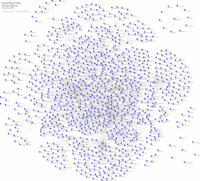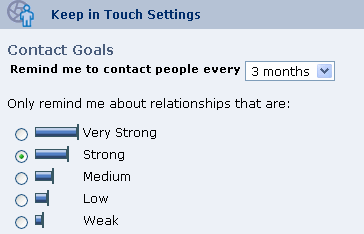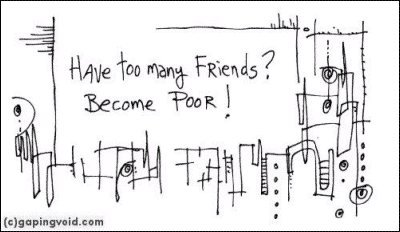 As someone who now has over 171 professional “connections” in my LinkedIn Profile, 198 “friends” on Orkut, many more non-intersecting friends and acquaintances on Tribe.Net, LiveJournal, and other social networking services, as well as a plethora of correspondents that I only interact with via email, I am trying reconcile a mismatch between my connections and my own Dunbar Number.
As someone who now has over 171 professional “connections” in my LinkedIn Profile, 198 “friends” on Orkut, many more non-intersecting friends and acquaintances on Tribe.Net, LiveJournal, and other social networking services, as well as a plethora of correspondents that I only interact with via email, I am trying reconcile a mismatch between my connections and my own Dunbar Number.
How do I maintain meaningful relationships with over 300 people?
Venture Capitalist Jeff Nolan relates similar concerns:
“It strikes me that the social networking theory holds that the more volume you have, the bigger your network will become by introducing degrees of separation roughly along the lines of Metcalfe’s Law. I disagree, human networks do not grow in value by multiplying, but rather by reduction. For me, it’s the quality of relationships that enhances my professional and personal life, not the sheer numbers.”
Ultimately social networking services – be it LinkedIn, Tribe.Net, Orkut, or LiveJournal – are making the problem worse, not solving it. Any engineer or information theorist can tell you that a system that only has amplifiers will be out of balance, and that you need attenuators in the system as well. Our current breed of social networking services have focused on amplifying our contacts not only because it serves us, but because it serves them. The more contacts that you make, the more people they potentially have in their service. However, in the long run this is unsustainable – a social networking service also has to be useful – merely amplifying your contacts isn’t enough.
Thus the problem becomes not just one unique to me, where my friends network is overextended, but rather one that’s endemic to the current generation of social networking services. In order to solve it we need to look at the traditional cultural answers to the problem, compare them to technical solutions, both current and to-be-invented, and then see how a new generation of social networking services can be designed that molds the two ideas together into a more cohesive whole.
I offer here the beginning of that discussion.
The Cultural Strategies
The problem of overextended social networks are not new with the Internet generation. Many professions require maintaining a large base of relationships and have done so for hundreds of years, among them: politicians, salespeople, public company CEOs, and even professions that you might not think of requiring these skills such as family doctors. The Dunbar Number of 150 may be a kind of species-wide average limit, it is not an individual limit – thus my guess is that people with an innate talent for maintaining more relationships are attracted to these professions. But even with innate talent those who follow these professions can be overwhelmed, and each have found different cultural strategies for managing larger numbers of relationships.
Cultural Strategy - Spending More Time: Some people just spend a lot more time keeping up with their connections. Politicians and salespeople are classic examples of professions that require significant schmoozing time in order to keep trusted connections together.
How does someone like a member of the US House of Representatives manage their relationships? In no way can they even come close to having a relationship with all the 645,952 people they represent. They would, however, at least have to keep up at some level with the other 435 House members, their own staff, key members of the staff of other House members, as well as key politicians and contacts back home. From what I’ve read, successful politicians spend most of their days just meeting with people, and have staff dedicated to “tickling” – keeping track of constituents, schedules, issues, etc. and reminding the politician before each meeting of the essentials they need to know.
The cost of this strategy is twofold – the time spent managing relationships can’t be spent elsewhere, and the quantity of relationships lowers the quality of those relationships. For instance, my experience with most politicians and many salesperson is that I will be forgotten as soon as I leave the room.
Cultural Strategy - Changing the Standard: There are different cultural standards in each profession as to what is an acceptable relationship. Thus some people chooose a profession that manages relationships in different ways. Doctors are a good example of socializers who fit into this category.
Your family doctor has a similar problem to that of politicians – too many people to keep track of. Yet a good family practitioner can see you and look beyond just today’s symptoms. Thus because of an ongoing relationship with you he can be a better doctor.
The way the doctor does this is through cultural and professional limits. Because of the authority, status and title granted to doctors, patients tend to defer to them. There is not an expectation that the relationship is equal. This allows the doctor to have a ‘shallower’ relationship with the patient that is still acceptable.
Still, even this level of serial, shallow socialization can be excessive for many people. A Radiologist acquaintance of mine told me the reason why she ended up in her specialty was that she just couldn’t handle the ongoing patient relationships required by other specialities – instead, she now looks at one set of images at a time, performs a diagnosis, and doesn’t have to retain any relationship to move on to the next patient.
There are also problems with changing your socialization standards. Unless it is culturally understood, or your standard is reciprocated by others, it can make you appear shallow and not trustworthy. I’ve seen this when someone moves from one profession to another, say a salesperson to a manager – styles of relationships that were acceptable among salesperson and between salespeople and customers are not quite as acceptable as those between managers and their staff. Another example is when someone moves from the East Coast to the West Coast, where the usefulness of casual alumni connections is significantly less valued, but those casual connections are unable to understand the change in standards.
Cultural Strategy - Prioritization: Perhaps a more common cultural strategy for managing excessive relationships is prioritization. I could prioritize my relationships and focus only on the 100+ or so that might be the most useful to me.
There are two problems with prioritizing. First, analyses of social networks show that it is often the weak and most unrelated links that can be the most important. Thus any attempt to triage may cut off some of these weak ties because I thought that the links might not be “useful”.
Secondly, how do you tell someone “I’m sorry, but I’m overly Dunbarred, so I have removed you from my list.” Rejection is painful (as MRI brain studies have actually shown), so I risk offending people forever by excluding them today.
The Technological Solutions
One of the great hopes of social networking services is to improve the ways that we interact with other people, particularly those that we know at a distance – the “weak links”. Right now, these services are part of the problem because they offer out-of-balance social systems. However, they can also be part of the solution; science-fiction writers and social software designers alike are starting to look at these issues and offer new solutions that would not have been possible before the advent of widespread software communication systems.
Technological Solution - Augmentation: 
I recently read in Geodesica: Ascent, a new science fiction novel by Sean Williams and Shane Dix, a futurist example of augmentation as a method of maintaining extended social networks.
In Geodesica: Ascent the protagonist, “Melilah” is a politician in the distant future. She has her own problems with the Dunbar Number, and solves it with her own personalized social networking service:
Two things she had learned from her political career were that society depended on interpersonal relationship networks, and that everything could turn on a simple misidentification. In her fifties she had set about ensuring that her memory remained in good working order in order to avoid the latter. Anthropologists had known since the twentieth century that people were born with a ceiling on their social groups. Once Melilah exceeded the Dunbar and Hill number of 150, and rapidly acquiring still more associates, it became progressively harder to keep track of everyone she had to know. As she passed her hundredth birthday, it became only worse. Some of her contemporaries option for cortical grafts and other memory prosthetics. She, motivated by a gut-level – some would say irrational – desire to keep her body as free of technology as possible, opted for other means.
She had found that using a name once every two months was enough to keep her memory fresh. Any longer than that between reminders, and the associations faded, rendering recall unreliable. So she programmed a complete list of her occasional acquaintances and enemies into a database and programmed it to cycle through them ever sixty days, shuffling the order each time.
A hundred years on, she was still in the habit of skimming fifty or so names a day, just to keep on the ball. By flicking through the images, voice files, place names, and more obtuse clues, she felt confident of recognizing any of the several thousand people more or less likely to interact with her at any point in the near future. The list had grown and shrunk down over the years, and many people had dropped off it entirely because of death or distance. Sometimes she added names to the list only to be surprised that they had been on it once before, decades ago, and she had forgotten them completely. That only reinforced the need for the list and the effort to keep it fresh in her mind.
I’m not sure that the Dunbar Number problem is solely one of “recognition”, as illustrated by Williams and Dix. However, I think this is a great example of seeing how a traditional cultural solution to network overextension (namely, “Spending More Time”) can be better applied by Social Software. In this example Melilah’s software automates the “ticklers” that politicians use.
 Already at least one social networking service has adopted a somewhat similar idea. Spoke has a “Keep In Touch” setting. The Spoke client software will watch your Outlook mailbox and addressbook to see how often you contact various people, and if you don’t email them or modify your address book entry for them periodically, will remind you that you should contact them.
Already at least one social networking service has adopted a somewhat similar idea. Spoke has a “Keep In Touch” setting. The Spoke client software will watch your Outlook mailbox and addressbook to see how often you contact various people, and if you don’t email them or modify your address book entry for them periodically, will remind you that you should contact them.
I’ve never used Spoke’s “Keep In Touch” feature – largely for privacy reasons (I was stung by a Zero Degrees Outlook extension), but also because Spoke seemed to be oriented toward salespeople and thus emphasized growing the network. My problem is not growing my network, but managing the network I already have more effectively. But I may have to take another look at Spoke. So, it doesn’t quite offer the same solution that Melilah used in the far-future, but it’s still a start upon that path.
Conclusions and Questions
I’m not certain that Spoke’s “Keep In Touch” feature, or Melilah’s social recognition reminder service are the full solution to the “Dunbar Triage” problem. However, they do at least offer a few examples of people looking at the problems, and how social software can help solve them.
As I’ve outlined here there are at least three traditional methods that we’ve used to manage Dunbar Triage prior to advent of social networking services: spending more time, changing standards, and prioritization. The technological solutions that I’ve offered up as an example concentrates upon the first of those cultural solutions, but it is by no means a conclusive statement on the issue.
How could next-generation social networking services improve upon the ideas of changing standards or prioritization? Could simple categorization help improve expectations for attention levels that various associates receive from you? Are there ways that social networking services, acting as an intermediary, could better manage disappointment-inducing events, such as a decision to spend less attention on an associate?
More so, could social software offer solutions that aren’t even being considered right now? For example, many Cyberpunk novels have suggested the ideas of avatars that can collect information for you on the ‘net while your attention is elsewhere. Could these avatars likewise maintain more distant social networks for you, without your full attention? Would that function even be desirable?
Some solutions are not technological – what new skills and changes to practices, etiquette and ethics are required for our ever expanding network of relationships? Or as Adina asks: “Who will offer us a 21st century, internet-augmented take on Dale Carnegie and Emily Post?”
As with any problem in the developing technical world, the first step is to define the problem and to consider possible solutions. Here’s the start: social networks can become too large, and many social networking services are causing the problem rather than solving it.
What’s your solution?
(comic illustration from the blog gapingvoid by hugh)
Some other posts about the Dunbar Number and group size issues:
Comments
I think the politicians and sales people use another strategy - they pretend that they keep up with the connections, but in fact they don’t. That’s why they have the people to keep them informed about people they are going to meet. They don’t remember the people but they use techniques to impress them that they do. And that is why we don’t like them. YASNS let us all switch into the politician networking mode. For some time I have beed thinking that Huminity which bases the networking on IM buddy lists is a step in the direction of making SNS more balanced, since it bases the networking on the most scarce Internet resource - user attention.
Zbigniew Lukasiak 2005-02-04T03:21:13-07:00
Nice post. A few random thoughts: This seems analogous to what happens when people move from rural communities with relatively sparse social options to the city. Another prioritization scheme is to emphasize face to face relationships, or to distinguish between real-time and non-realtime relationships. These are not always appropriate filters, but because getting f2f or talking realtime requires a special effort, I’ve found these approaches can help me gauge whether a relationship is maintainable. The older system of etiquette, which separated personal from professional relationships, is another approach, though when I hear the words “I don’t do business with friends,” it means someone neither a friend nor a business associate. Perhaps there are some other frames for looking at this, e.g. time management or attention management, or as another instance of the Tyranny of Choice. Approaching the problem as one of more choice in who we pick to be our friends and associates, or as one of more demand on us from others also colors our choice of solutions.
Jeff Ubois 2005-02-04T12:03:24-07:00
One way of putting the brakes on endlessly expanding contact lists is to have the SNS site charge per contact. If you really need more than 100 contacts then you’d pay for them, but if not then when you’ve got another 1 person you want to add to your list you’d consider dropping one off your current list. It might work better with per-contact charges, so you’re not forced into making a decision when you hit the package borders (101, 201, etc) Not only does it counter the pack-rat mentality, but it also provides a business model. Another idea I had was if the SNS would provide me with a continuous feed of updates and changes in the profiles of my contacts - I occasionally notice that some contact of mine has changed jobs, but more likely I wouldn’t notice. The list of contacts just sit there, passive. This feedback would provide two forces: (1) the memory refreshing effect, and (2) the opportunity to drop those contacts that are moving into areas I don’t care for. A third idea: I’d like it if the SNS I use (LinkedIn) allowed me to attach some notes or tags to each contact in my list … I have a few there where I have to think really hard just how I happen to know them. Right now it seems that every SNS I look at lets me make connections, but every connection is bland and generic. The system is relying on me remembering why I know that person, when instead it could remember it for me. When it comes time to triage, I’d really like it if the SNS would provide a simple network map for me. Show me my immediate contacts, any connections they have amongst themselves, and my second circle contacts (anonymised if necessary). This way at least I can see that Person X is a gatekeeper to a whole different community from all my other contacts, and so should reconsider dropping them.
Eric Scheid 2005-02-04T18:44:02-07:00
Eric Scheid has the right idea… but his number of 100 is still too high. His last paragraph is golden. When I first joined RYZE in 2002 [ no longer an active member] I mapped out my 1 and 2 step network there. In the diagram linked below I am the green node, my immediate neighbors are in blue and my two step contacts are in grey. The network map reveals why Eric’s 100 number is too high… http://www.orgnet.com/RYZE2a.gif
Valdis 2005-02-05T10:02:26-07:00
This, and the earlier article on Dunbar numbers are interesting reading. I’m not sure whether the Dunbar number applies in all cases. In some discussion on SNs recently, I theorised that if we analysed Social Networks that there would be people who maintained relationships in Groups, i.e meshes where everyone knows everyone. Bridging between groups occurs because of multiple membership, i.e. person X knows all the parents in their kids soccer club, AND all the people at the office. Dunbars number, and the theories around it, seem to apply here, i.e. to the social-grooming required in GROUPS. There would also be people who maintain relationships, between a lot of people who mostly do NOT know each other. We used to call these people Networkers, and typically they are the people you call when you want to know who to talk to about some topic where you have no personal connections. I’m not sure whether the Dunbar number applies to those people’s connections, probably the power-law applies better, i.e. they can maintain progressively more distant connections with progressively more people. Anecdotal, if you randomly pick people in for example Orkut then you’ll see the same names turn up as intermediates in many cases. This is not necessarily because those people have large numbers of Orkut friends, but because their Orkut friends are dispersed over a range of sub-groups. I don’t think that any of the SN tools do a good job of managing these kinds of relationships yet, in particular the lack of interworking between them causes problems as different Groups tend to belong to different SN systems, so the bridges are often not evident. Also the relative strength of a connection doesn’t seem to drive the ranking of possible connections, i.e. I’m just as likely to be presented with a potential introduction through a person with a weak connection to the target, than through someone with a strong connection. - Mitra
Mitra 2005-02-05T15:40:27-07:00
On tactic that comes to mind is the automated equivalent of an 18th/19th century butler, who mediated social interaction at a time when the intrusive, in-person visit was one of only two ways to make social contact. The butler has broad and nuanced knowledged of the circumstances in which the Lady is to be acknowledged to be IN. Today’s online presence indicators are flat; they tell everyone the same message; that one is working, or eating ice cream in front of the television. A butler would understand whether one is working or not, and would put through different connections at different hours. A butler would understand the understand the nuances of one’s social circle, and admit some people automatically, allowing others to wait, and requiring still others to leave a message. We also need the 18th/19th century interface to the Butler, the calling card, which conveys by its printed message and accompanying whether the caller is a longlost relative whom the butler may not remember; a recommendation from a reputable source; a specific message about the urgency of the visit.
Adina Levin 2005-02-06T08:42:20-07:00
I think that the key to defeating the Dunbar number is to a) establish a real relationship to begin with and b) massage that relationship at least once per year. I find that if I’ve built a meaningful relationship with someone, based on some shared experiences, simply getting in touch with someone once a year on their birthday is enough to keep the relationship alive.
Chris Yeh 2005-02-07T06:25:46-07:00
You’ve got to distinguish between “friends” and everything else - the relationships that range across acquaintance, association, colleague and just plain “potentially useful.” Why treat them all with the same UI? Why not invite your true friends to share a more intimate online relationship and keep the rest in the “relationship parking lot” of an Orkut? Yeah, I know that friends are often useful, too, but they deserve better than to share the same utilitarian role as that guy you met at SXSW last year. I’ll invite my real friends into my Grouper hangout, but I’m not a Congressional Rep, so I don’t need to be responsible to hundreds of familiar names. I’ve got plenty of other things to do with my time, which I believe is the case with most of us.
Cliff Figallo 2005-02-07T15:53:49-07:00
Hi, Crhis. Three years’ ago Adrian Scott asked this question too, and it led to his founding Ryze… from: http://www.edge.org/q2002/q_scott.html Edge.org’s Question Page of 2002 - by Adrian Scott. ** “How do we scale up the number of quality human relationships one person can sustain by many orders of magnitude? In an increasingly connected world, how does one person interact with a hundred thousand, a million or even a billion people?” Our one fixed resource is time — human attention. As we become increasingly networked in the technological sense, we also become more networked in the social sense. As our social networks scale up, we move more and more of our interactions to the technological sphere. We can have many more telephone interactions than we can have hand-written letter interactions. When we move from telephone to e mail, the number of interactions between people goes up even more dramatically. Then we pair our e-mail interactions with a personal Web site, and we start moving our personalities into the technology net, as a way of automating and scaling up the number of relationships even further. We end up with personal CRM systems to handle our increased interaction load, and then add interfaces from our technology net to our human forms. These interfaces will develop from current-day Palm Pilots and Blackberry’s to heads-up display style interfaces in glasses and eventually retinal and neuronal interfaces. “Hi Jerry, Ahh.., we met back in 1989, May 14th at 7pm, and since then we’ve exchanged 187 e-mails and 39 phone calls. I hope your cousin’s daughter Gina had a wonderful graduation yesterday.” The whole range of interactions becomes organized. Introductions from one person to another, and rating systems become automated. Currently many people run into barriers as their personal networks approach the range of thousands of people. Soon they will move to the tens of thousands, to the millions and beyond. With these trends, the friction costs of personal introductions go down, and consequently the value of quality measurement and gatekeeping go up dramatically. As the depth of knowledge in a relationship increases, the threshold point at which you ‘really know someone’ increases also. It’s an arms race of intimacy. Adrian Scott is founder of Ryze, a business networking community. He is a founding investor in Napster, got his Ph.D. in nonlinear optimization at age 20, and has sung with Placido Domingo and performed with the NYC Ballet. *****
Phil Wolff 2005-02-07T20:12:12-07:00
URL: An Avatar? Maybe that’s what I’m doing. I look at life as a whole. Coincidences (for lack of a non-cliched word) are road signs helping us determine a direction of movement (not necessarily in the physical realm). I’m working on a software module which links coincidental interaction within Nature and published human consciousness. Currently I’m modeling Climate Change. For my software to ultimately work within a social network, a persons daily life of data would be connected via an identifier - and freely available. Too, an aspect of human momentum would need to change dramatically - we would trust that life is a whole and not something to be mastered, assimilated, conquered. We would need to move to a much less mechanical decentralized world. And our user base would need to be decreased. Which coincidentally, Climate Change is forcing upon us. And it’s ramping up. Google, with all the tools I need (email, blog, webpages, and soon a social network site) seemed like a potential opportunity. They never responded to my email :) My profile is lost within LinkedIn…
michael white 2005-02-20T10:05:53-07:00
Learning by Subtraction The human brain has on half the number of synapses at age six as it had at age two. It learns by subtraction. So do computer based neural nets. This principle could well be applied to organizations to increase the size of the Dunbar number that could work effectively without drowning in bureaucracy. Consider three ways to bring order in a human organization. The chain of command, community spirit and marketplace choice. The chain of command tends to keep demanding ever more connections. You must get permission from all these people before taking action. The free intraprise systems we set up (See The Intelligent Organization by Gifford & Elizabeth Pinchot and link at the end of this post) allow people to connect and disconnect at the end of each contract at will. Teams contract with line officers and each other to get the work done, much like a virtual organization except that key competencies and trade secrets remain in the organization. Relationships that create value are maintained; those that consume value are terminated by either party. This provides a powerful advantage over the innane connections that are often maintained in highly time consuming ways in a bureaucracy. The force of community also has a self-organizing quality that allows people to volunteer for what has juice and walk away from relationships that consume purpose and meaning. Community is a necessary balance to free enterprise or free intraprise. Both should be used in place of the chain of command in many of the situations where the chain of command is used today. http://www.pinchot.com/MainPages/BooksArticles/InnovationIntraprenuring/FreeIntraprise.html http://www.pinchot.com/MainPages/BooksArticles/OtherArticles/GiftEconomy.html
Gifford Pinchot 2005-02-23T22:43:50-07:00
Adina: Getting in touch once a year may keep a relationship alive, but only just. This begs the question, what do you want from your relationships? What do you value them for? What is the point in keeping a relationship on drip-feed attention when putting so little in precludes the possibility of growth, of enrichment, of greater intimacy, of learning something, of sharing the experience of life in some way. Perhaps what we’ll see, with or without the help of clever internet applications, is a polarisation: a small circle of close friends, a very wide circle of friendly acquaintances (whether social, professional, shared interest, discussion group, blog reader, etc, by origin), and an almost infinite range of potential one-off contacts. Along the lines Chris Reh is suggesting, I think. I’m not sure I need to know which of my friendly acquaintances are in touch with one another. Better just to get on and live, and concentrate on putting something into those relationships, the better to get something out of them. Or have I missed the point?
Fred 2005-03-30T21:48:58-07:00
Fred, is there someone in your household who sends birthday cards and holiday cards? These are traditional tools for staying minimally in touch. They don’t maintain intimacy, but they do keep an open door, so that it’s easier to keep the benefits of weak ties, and regain contact when the time is right.
Adina Levin 2005-04-09T13:26:17-07:00
I just had a minor realization: when we speak of “dropping” someone from our personal network, are we really doing that? The fact is, they are very probably connected to other people we do know, and so what we are really doing is *delegating* the intimate relationship to someone we also know. Being able to see a map of my local network would help a lot in deciding whether to cut someone loose or not.
Eric Scheid 2005-07-30T01:53:38-07:00
Life With Alacrity
© Christopher Allen


